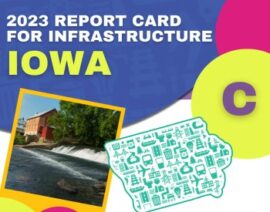Inland Waterways
Startup Uses Drone for Cleaning Water, Collecting Data

Iowans depend on roads, bridges, aviation, rail, water systems, energy, solid waste, recycling, and recreation facilities daily. With this system of systems, engineering provides the essential foundation for improving quality of life and opportunity: safety, reliability, resilience, access, and equity. Experts from the state produced the 2023 Report Card for Iowa’s Infrastructure so residents understand the positive and concerning trends with their state’s infrastructure. The report card provides a performance analysis for policymakers to engage in conversation about current conditions and act to improve the built environment.
Analyzing the latest public data, engineers writing in 2023 conclude much of the state’s infrastructure is treading water. Following on the 2019 report card, this new iteration holds Iowa infrastructure steady at “C” grade overall, with roads climbing to “B-” and Solid Waste dropping to that grade. Landfill capacity is estimated to be adequate until 2044, but household waste increased to 1.22 tons per capita in FY 2021 and recycling rates are relatively low at 0.12 tons per capita.
The Iowa roads grade increased after successful state of good repair work funded by the 2015 gas and diesel tax increase. Iowa DOT focuses on a “fix-it-first” approach to project planning and spending decisions which improve pavement conditions. Iowa’s bridges remained at “D+”, after four years of successful focus on state-owned bridges. Iowa’s Department of Transportation notably achieved a 26% reduction in the total of poor condition structures. Yet, Iowa still has the highest number of structurally deficient bridges in the country, many of them local bridges. In the last four years, bridges owned by cities and counties only reduced their numbers of poor bridges by 5% and 4% respectively. Today, all but 30 of Iowa’s 4,599 poor bridges are owned by local governments. Those localities face severe funding constraints, requiring significant investment and upgraded project delivery capabilities. The 2021 Bipartisan Infrastructure Law is set to spend more than $432 million on bridge projects in Iowa, with a portion reserved specifically for “off-system”, or local bridges.
The Report Card found that Iowa can be better prepared for increased flooding frequency and severity. Iowa communities have already demonstrated forward-thinking by coordinating investments and water decision-making based on watersheds rather than political jurisdictions. Much more is needed, starting with the state legislature fully funding the Natural Resources and Outdoor Recreation Trust Fund. Targeted investments will enable infrastructure to withstand and protect against flooding and other natural disasters.
Despite concerns with resilience, the future looks bright. Additional recommendations below provide insight needed to start conversations and ignite action to raise the grades.
Aviation is key to many Iowans: visiting family on a commercial airline, utilizing a business-owned aircraft to reach remote places, maintaining agricultural fields from above, or receiving freight in cargo planes. The overall condition of Iowa’s aviation infrastructure is relatively stable. Pavement conditions continue to deteriorate with age, though 73% of airport pavement remains in good or fair condition. While aviation funding has grown in recent years ($64.4 million annually between 2010 and 2019), those investments are less than the need to replace or repair components in poor condition — an estimated annual need of $126.6 million. Efforts should continue to maintain the existing system as well as expanding its capacity to meet growing demand.
There are 23,799 bridges in Iowa, the seventh largest bridge stock in the nation. The Iowa Department of Transportation owns 4,195 bridges, counties own 18,365 bridges, and cities own 1,239 bridges. One in every five bridges in Iowa is rated poor, giving the state the worst ranking in the nation by number of poor bridges, and seventh worst by poor bridge deck area. Reducing the number of poor bridges is an Iowa DOT priority: over the last four years, it achieved a 26% reduction in state-owned poor bridges. However, all but 30 of Iowa’s 4,599 poor bridges are owned by cities and counties. They face serious funding constraints and reduced their poor bridge numbers by only 5% and 4%, respectively. Locally owned bridge improvements require significant investment and increased project delivery capabilities.
There are currently 4,270 Iowa dams, over 4,030 of which are state regulated dams. Of the total dams in the state, 2,055 are privately owned. Iowa’s State Dam Safety Program budget has remained unchanged for the last five years. The average budget for Iowa’s regulated dams of $29 each is significantly lower than the national average of $799 per regulated dam. Approximately 54% of the state’s high-hazard potential dams have emergency action plans, compared with approximately 83% nationwide. Iowa does not have a state loan or grant program to assist dam owners with rehabilitation projects and many structures are aging beyond their original design life.
Approximately 92.3% of Iowans are served by public water systems (PWS), nearly all of which connect less than 3,300 residents and 71% less than 500 people. Public health violations are trending downward. In 2021, 70 systems had 107 violations compared to 151 PWS incurring 259 violations in 2011. Rural water systems are relatively new in Iowa, requiring lower maintenance, but municipal water systems report most of their distribution system is beyond expected usable life. Few, if any utilities are reinvesting in their underground infrastructure at the recommended rate of 1% to 3% of the value of their system. PWS need additional revenue for maintenance and replacements of older components, to expand water sources, and install more advanced treatment facilities for a growing list of chemicals and nutrients.
Iowa is served by three private, investor-owned utilities, 136 publicly owned utilities, and 43 rural electric cooperatives. About 60% of Iowa’s total electricity generation came from wind in 2020. However, partially due to insufficient storage, excess wind energy is sent out-of-state more often than consumed at home. Natural gas – not wind – is the most used energy source in Iowa. In addition to building out renewable storage capacity, Iowa’s energy network needs investments to modernize the grid and improve its resilience. “Last mile” distribution lines are overwhelmingly the cause of outages. Iowa’s aging grid exacerbates fragility. More powerful storms increase challenges, as the roughly 250,000 Iowans without power in the aftermath of the 2020 Derecho will remember.
The Upper Mississippi River (UMR) and Missouri River provide an efficient and cost-effective transportation mode to export Iowa products. Waterways and ports contributed more than $18.7 billion in revenue to the state’s economy and supported an estimated 101,000 jobs in 2018. However, revenue and security of jobs are threatened by aging navigation locks and dams. Their average age in Iowa is 85 years old, or 35 years past their intended design life. Unscheduled lock closures for maintenance cause delays and congestion, which can cost $739 per hour for an average tow. These costs are passed on to the consumer. Unexpected closures from 2010 to 2020 averaged 3,881 hours annually across Locks and Dam 9 through 18 in Iowa. Recent funding appropriated to the Navigation and Ecosystem Sustainability Program (NESP) will improve navigational capacity and provide ecosystem restoration.
There are 181 documented levee systems totaling 862 miles in Iowa. These structures – either earthen embankments or concrete and steel floodwalls – protect an estimated 55,000 buildings with an associated property value of $32.2 billion. Most major levees in Iowa are currently functioning adequately when exposed to normal storm flows, but there are serious concerns about levee stability during major rain events. This is especially true in rural areas, which are struggling to obtain state and federal grant dollars or raise required matching funds. Communities have begun to respond by investing in flood infrastructure on a watershed approach rather than piecemeal. Coordinated strategies can’t come soon enough; it estimated that Iowa needs $10 billion of flood and watershed quality improvements.
Visits to Iowa recreation sites have increased since 1995 and in 2021, rose to a record 16.6 million, increasing need for investment to manage and maintain parks. Unfortunately, a 2019 report revealed funding fell from $6.6 million in 2010 to $5.7 million in 2019 – a 26% decrease adjusted for inflation – before rising modestly to $6.2 million in 2021. In 2017, the Iowa Association of County Conservation Boards identified a $664.4 million backlog of project needs for parks and recreation entities. The Iowa Water and Land Legacy identified $44.5 million in stalled shovel ready recreational projects. Iowa’s Legislature can take immediate action by funding the National Resources and Outdoor Recreation Trust Fund, approved by 63% of voters.
Iowa’s rail network consists of over 4,000 total miles of track owned by five Class I railroads, one Class II railroad, and 13 Class III railroads. Amtrak operates two long-distance routes over freight rail lines; six depots board an average of 60,000 passengers annually. A new Chicago to Iowa City passenger rail line has been awarded federal funding. In general, Iowa’s freight railroads have adequate capacity and are in good condition. However, chokepoints exist, sometimes the result of insufficient track capacity due to size and weight restrictions. Just 45% of public at-grade highway-rail crossings have flashing lights and/or gates, but the state is receiving federal funding from the 2021 Bipartisan Infrastructure Law to improve safety at unprotected locations.
A 2015 increase in Iowa’s fuel tax helped improve pavement conditions statewide. Today, 25% of Iowa’s roads are in poor or mediocre condition, down from 29% in 2019. Iowa’s rural roads have disproportionate deficiencies, but the state has made positive progress there too. Of Iowa’s rural roads, 6% are rated in poor condition and 14% are rated in mediocre condition, compared to 15% and 19% respectively in 2019. Pedictable freight movement will be critical with truck tonnage projected to grow by over 26% in the next 20 years. The federal Bipartisan Infrastructure Law will provide approximately 30% more highway-related funding for the Iowa Department of Transportation in the short term. However, inflationary pressures have left a $111 million funding gap in the current highway five-year program.
Solid waste infrastructure includes 47 active landfill sites in Iowa, with one site soon closing. Capacity is estimated to be adequate until 2044. The COVID-19 pandemic and 2020 derecho created a significant increase in per capita waste generation. Iowans produced approximately 3.91 million tons of municipal solid waste in fiscal year 2021, or 1.22 tons per capita. Iowa diverts waste material from landfills through recycling and composting rates in the top 10 nationally. This results in 233 pounds (0.12 tons) recycled per capita per year. Market threats to recycling programs and non-recyclability of many materials present challenges to long-term viability. New techniques and technologies have the potential to enhance solid waste management in the state.
Over 70,000 miles of streams and 117,000 acres of lakes and ponds in Iowa have quality directly related to the state’s stormwater management systems. In 2022, more than 55% of Iowa’s assessed rivers and streams were impaired; another 23% require more investigation for a determination. With at least 95 stormwater utilities, Iowa has more per capita than any other state. Additionally, 27 Watershed Management Authorities cover about 40% of the state. To date, WMAs have implemented more than 800 projects to reduce the magnitude of downstream flooding and improve water quality. Future improvements are urgent; from 1953 to 2018, Iowa had more disaster declarations due to flooding than any other state in the nation, a trend that’s likely to continue.
Iowa residents depend on wastewater infrastructure to collect, treat, and safely distribute waste. Specific wastewater needs are difficult to report until the federal government completes a new Clean Watershed Needs Survey expected late 2023. With available information, Iowa is holding steady. Since the 2019 ASCE Report Card for Iowa’s Infrastructure, communities have constructed several new treatment plants replacing old structures and upgraded several treatment plants for tougher limits on chemicals and nutrients. Underground wastewater equipment in Iowa is often aging past their useful life, undersized for residential growth, or made of inferior materials and require costly removal and replacement. Iowa received money from recent federal legislation to improve water infrastructure, but much of the spending discretion and implementation lies with localities – the results of which are yet unseen.
A: EXCEPTIONAL, B: GOOD, C: MEDIOCRE, D: POOR, F: FAILING
Each category was evaluated on the basis of capacity, condition, funding, future need, operation and maintenance, public safety, resilience, and innovation

Aviation
$12.5 million in 2022 airport improvement grants across 7 major airports

Drinking Water
$10.1 billion total drinking water need

Transit
10 million passenger trips across 35 systems in 2021

Bridges
23,870 bridges, 18.9% of which were structurally deficient in 2021

Hazardous Waste
25 Superfund sites

Wastewater
$2.4 billion total wastewater need

Dams
95 high hazard dams

Levees
771 miles of levees protect $6.8 billion of property

Roads
25% of roads are in poor or fair condition
Smart investment will only be possible with strong leadership, decisive action, and a clear vision for our nation’s infrastructure.
If the United States is serious about achieving an infrastructure system fit for the future some specific steps must be taken, beginning with increased, long-term, consistent investment.
We must utilize new approaches, materials, and technologies to ensure our infrastructure can withstand or quickly recover from natural or man-made hazards.

Iowa State Report Card: Civil Engineers Give Iowa’s Infrastructure a “C” Grade
April 11, 2023
On Tuesday, April 11th, the Iowa section of ASCE released the 2023 Report Card for Iowa’s Infrastructure in Des Moines. The report card included 13...
 Link to Post:https://infrastructurereportcard.org/asce-gives-thanks-in-2019/">ASCE Gives Thanks in 2019
Link to Post:https://infrastructurereportcard.org/asce-gives-thanks-in-2019/">ASCE Gives Thanks in 2019November 21, 2019
We rely on our infrastructure every day, but on Thanksgiving, it’s especially clear that our built systems play a critical role in supporting or lives....
 Link to Post:https://infrastructurereportcard.org/resilience-revolving-loan-fund-helps-cities-and-states-prepare-for-the-future-now/">Resilience Revolving Loan Fund Helps Cities and States Prepare for the Future Now
Link to Post:https://infrastructurereportcard.org/resilience-revolving-loan-fund-helps-cities-and-states-prepare-for-the-future-now/">Resilience Revolving Loan Fund Helps Cities and States Prepare for the Future NowResilience Revolving Loan Fund Helps Cities and States Prepare for the Future Now
September 20, 2019
We’re at peak hurricane season, with the recent Hurricane Dorian squeaking by the Carolinas, but devastating the Bahamas. At the same time in Houston, torrential...